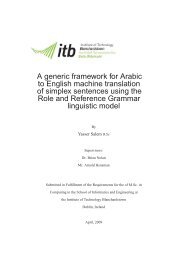On the occurrence and consequences of inaccurate ... - Acsu Buffalo
On the occurrence and consequences of inaccurate ... - Acsu Buffalo
On the occurrence and consequences of inaccurate ... - Acsu Buffalo
Create successful ePaper yourself
Turn your PDF publications into a flip-book with our unique Google optimized e-Paper software.
E.R. Odders-White / Journal <strong>of</strong> Financial Markets 3 (2000) 259}286 267<br />
Table 2<br />
Performance <strong>of</strong> <strong>the</strong> algorithms<br />
The table below contains a comparison <strong>of</strong> <strong>the</strong> true classi"cation (buy or sell) to <strong>the</strong> classi"cation<br />
from <strong>the</strong> quote (Panel A), <strong>the</strong> tick (Panel B), <strong>and</strong> <strong>the</strong> Lee <strong>and</strong> Ready algorithms (Panel C).<br />
A description <strong>of</strong> <strong>the</strong>se methods is contained in Section 2 <strong>of</strong> <strong>the</strong> text. Each entry contains <strong>the</strong> number<br />
<strong>and</strong> percentage <strong>of</strong> transactions in <strong>the</strong> sample that fall into <strong>the</strong> respective category. Analyses are<br />
based only on transactions for which <strong>the</strong> true initiator can be determined.<br />
Method <strong>and</strong> classi"cation True buy True sell<br />
Panel A: Quote method vs. true classixcation<br />
Number Percent Number Percent<br />
Quote method: Buy 127,827 40.15 14,997 4.71<br />
Quote method: Sell 13,893 4.36 110,870 34.82<br />
Quote method: Unclassi"ed 26,308 8.26 24,469 7.69<br />
Panel B: Tick method vs. true classixcation<br />
Tick method: Buy 134,649 42.29 34,662 10.89<br />
Tick method: Sell 33,379 10.48 115,674 36.33<br />
Panel C: Lee <strong>and</strong> Ready method vs. true classixcation<br />
Lee <strong>and</strong> Ready method: Buy 144,348 45.34 24,183 7.60<br />
Lee <strong>and</strong> Ready method: Sell 23,680 7.44 126,153 39.63<br />
<strong>of</strong> transactions classi"ed correctly, <strong>the</strong> Lee <strong>and</strong> Ready method (Panel C) is <strong>the</strong><br />
most accurate. The quote method (Panel A) performs relatively well on <strong>the</strong><br />
transactions that it classi"es, misclassifying only 9.1% <strong>of</strong> <strong>the</strong> transactions in <strong>the</strong><br />
sample (4.36% from buys plus 4.71% from sells 9.1%). The quote method<br />
leaves almost 16% <strong>of</strong> <strong>the</strong> transactions unclassi"ed, however. The tick method<br />
(Panel B) misclassi"es 10.48%#10.89%21.4% <strong>of</strong> <strong>the</strong> transactions, while <strong>the</strong><br />
Lee <strong>and</strong> Ready method misclassi"es only 7.44%#7.60%15.0% <strong>of</strong> <strong>the</strong> transactions.<br />
Note that <strong>the</strong> percentage <strong>of</strong> misclassi"ed transactions is fairly symmetric,<br />
with sells being misclassi"ed as buys slightly more <strong>of</strong>ten than <strong>the</strong> reverse by<br />
all three methods. Since <strong>the</strong> Lee <strong>and</strong> Ready method is <strong>the</strong> most accurate method<br />
overall <strong>and</strong> is used most <strong>of</strong>ten, <strong>the</strong> remainder <strong>of</strong> <strong>the</strong> discussion focuses on this<br />
algorithm.<br />
Recall that Lee <strong>and</strong> Radhakrishna (1996) found a 93% accuracy rate for <strong>the</strong><br />
Lee <strong>and</strong> Ready method. Their accuracy rate exceeds <strong>the</strong> 85% rate found here<br />
because <strong>the</strong> trades that <strong>the</strong>y eliminate are more likely to be misclassi"ed by <strong>the</strong><br />
algorithm. Speci"cally, <strong>the</strong> subset that <strong>the</strong>y eliminate has an 81.5% accuracy<br />
rate, as opposed to <strong>the</strong> 93% rate <strong>the</strong>y documented using <strong>the</strong>ir subsample. This<br />
di!erence is not driven entirely by <strong>the</strong> inclusion <strong>of</strong> stopped orders in my sample.
















